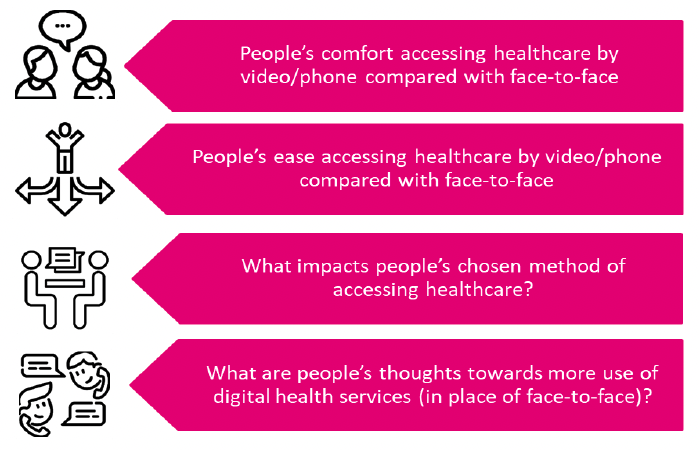Scottish Social Attitudes Survey 2021/22: public views of telephone and video appointments in general practice
Findings from the Scottish Social Attitudes Survey (2021/22) of public views towards face-to-face and remote appointments in General Practices. The key themes of the research are to understand comfort, ease, influences on, and impacts of remote appointments on public attitudes.
6. Conclusions and Limitations
This report has presented findings from the Scottish Social Attitudes Survey researching public attitudes towards different types of appointments in general practice. The results, based on a nationally representative sample of 1,130 people aged 16 and over, have been discussed in relation to the 4 themes outlined at the beginning of the document[6]:

6.1 Policy implications and suggestions for further research
The survey results highlight the diversity in attitudes towards accessing general practice appointments remotely. Attitudes towards appointment type were impacted by both comfort and ease, where participants preferred face-to-face for comfort and phone for ease. Video appointments in general practices seemed to be the less favorable option for the people of this survey, a finding reinforced by the additional literature referenced in this report. Equally the variation of responses based on demographics and characteristics, highlight a range of factors that may influence people's preferences and concerns as well as areas that require further investigation. For example, good general health, frequent internet use, and high satisfaction with the NHS were linked to a more positive response across all three modes of appointments. This survey did not find any significant differences for SIMD and education, however this may also reflect limitations of the methodology and these may be key areas for future research. Similarly, this survey cannot account for the differences experienced by people from remote and urban settings. Therefore, the needs of the patient, clinical judgement, and service efficiency/effectiveness should be central to ensuring that digital and remote appointments are enhancing patient care and safety.
6.2 Limitations
6.2.1 Questionnaire
- The space for questions was limited in order to keep the questionnaire concise therefore the scope of the questions were not enough to give further information about the reason for choosing a particular answer (e.g. did not include a question about what experience the respondents had with each mode of appointment thus, we are unsure if the responses are based on experience or opinion). In addition, the questions were closed and no further information could be provided about why answers were chosen. Further research, that includes both quantitative and qualitative approaches, specifically about remote services would gather a broad and more extensive evidence base.
- As the questions were based on opinions about doctors and/or nurses, further information is required that encompasses other workers within primary care and multidisciplinary teams who see patients through remote versus face-to-face consultations. There may be other preferences based on who the patient is seeing, for example they might prefer to see a community link worker remotely but a GP through face-to-face/over the phone.
- As this survey highlighted that how worried people were about their condition would impact their choice to accept or decline a remote appointment, further research would be required to assess how different reasons for contacting a primary care worker (and who they are) may impact on appointment method.
6.2.2 Respondents' Characteristics – Significant Differences
- There was little scope to assess the impact of intersectionality through this survey due to the sample size and not being able to include relevant questions. As highlighted by the 2020 Near Me Equality Impact Assessment intersectionality plays a role in experiences of health care and should be examined further. The results of this survey showed that those with better general health, more frequent use of the internet and higher NHS satisfaction are more likely to find appointments easier/comfortable. These respondent characteristics could be linked to demographics such as being younger in age, an intersection between the above that could be explored in future research.
- Language may have an impact on preferred choice of appointment method, so good quality evidence on the attitudes and experiences of people whose first language is not English would provide valuable evidence to help services meet patients' appointment needs.
- As mentioned in the 2020 Near Me Equality Impact Assessment, those from the LGBT community or an ethnic minority background may experience more adversity in health care settings. This survey was unable to generate sufficient data in the number of responses to allow for robust analysis so cannot comment on the links. Therefore future research would require a larger, representative sample of the Scottish population to draw conclusions from. As well as creating bespoke research or surveys to focus on adversely impacted groups.
- Due to the impact of COVID-19 and restrictions limiting face-to-face contact, this survey was conducted via telephone. This method may have excluded certain populations such as individuals who do not have access to a phone and thus, who are negatively impacted by remote appointments, a key user experience that needs captured.
Contact
Email: socialresearch@gov.scot
There is a problem
Thanks for your feedback